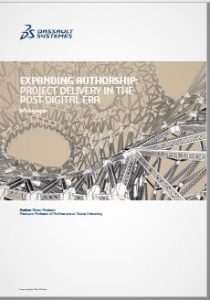Extract of a white paper written by Author: Adam Modesitt, Assistant Professor of Architecture at Tulane University

Download the full white paper: Expanding Authorship: Optimize BIM for Integrated Engineering, Design, and Construction Management
The post-digital era
Digital technology has transformed AEC to the extent that the current era is now commonly described as “post-digital.” Rather than indicating that the importance of digital tools has plateaued or waned, the term expresses the total infusion of digital technology into every aspect of AEC production. Communication of all forms have become digital. Cloud-based search engines provide instantaneous access to massive volumes of information. Project information from every phase is manifest digitally, from concept design to post occupancy building management. Even physical construction is increasingly digital, enabled by CNC fabrication, robotics, and computational simulation. There no longer exists a distinction between digital work and other forms of work— all production is now mediated by digital processes, well past meaningful lines of division. The post-digital era is characterized by increasing integration between immaterial, digital production and material, physical production.
The post-digital era has brought with it the promise of seamless interconnectivity across all modes and forms of AEC production. Yet this potential remains largely unrealized. The drawings of Alberti’s era, albeit digitized, remain the predominate form of contractual, regulatory, and construction information exchange. Digital modeling tools have fractured into a growing number of formats, types, and methods. Digital technology adoption is unevenly distributed across disciplines and firms. Why hasn’t production in AEC achieved greater integration, and with it new possibilities for project authorship? Reasons vary, but largely correspond to the challenges of a greatly expanded field of digital production.

Digital project information has exploded
The quantity and diversity of digital project information has exploded in the post-digital era. Even the smallest projects generate thousands of digital communications. New digital information formats, such as computer code, fabrication routines, and computational analysis now exists to be integrated into projects. Projects generate vastly greater quantities of specialized digital information, from energy analysis, to on-site laser-scanning, to sustainability modeling, to post-occupancy life-cycle data. Projects generate not only 3D building information, but 4D information such as construction sequencing modeling. Direct-to-fabrication and building simulation generates additional digital information. In parallel, the scope and requirements of material production has expanded. Construction tolerances have narrowed. Project delivery schedules have been compressed, accelerating everything from visualization to construction schedules. Lastly, architectural design has expanded to include a greater range of building types, styles, and forms.
AEC firms must now navigate a field of expanded material and immaterial production. Generating traditional technical drawings in digital form is increasingly insufficient for project delivery. Traditional disciplinary silos no longer provide an effective framework for collaboration. To compete in an increasingly complex and fractured digital landscape, AEC firms must work across overlapping and blurred disciplinary silos. The post-digital era has also created enormous opportunities expanded roles and scopes in project delivery. There exists no singular, one-size-fits-all approach. Rather, firms must position their authorship amidst the expanded field of knowledge, tools, and workflows.
Expanded project authorship in the post-digital era
Expanded project authorship in the post-digital era requires software platforms that do more than merely reproduce traditional workflows digitally. Platforms in the post-digital era must integrate a wide range of digital information. They must manage how digital project information is created, organized, distributed, and retained. Platforms in the post digital era must be adaptive. Rather than prescribing a single workflow, they must enable custom and non-standard processes. Platforms in the post-digital era must encapsulate project knowledge and retain new information. They must facilitate collaboration across former disciplinary silos. They must enable firms to amplify and extend their expertise. As outlined in the following four categories, platforms in the post-digital era must allow for expanded project authorship throughout the project delivery.
Download the full white paper: Expanding Authorship: Optimize BIM for Integrated Engineering, Design, and Construction Management
Related Resource
Shared Knowledge is Shaded Power
Dassault Systemes’ Architecture, Engineering and Construction Solutions


 Tweet: The post-digital era has brought with it the promise of seamless interconnectivity across all modes and forms of AEC production @3DSAEC #3DEXPERIENCE https://ctt.ac/S3dia+
Tweet: The post-digital era has brought with it the promise of seamless interconnectivity across all modes and forms of AEC production @3DSAEC #3DEXPERIENCE https://ctt.ac/S3dia+